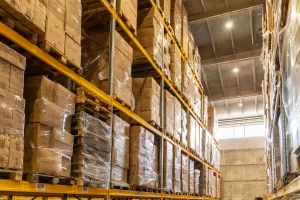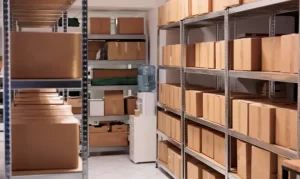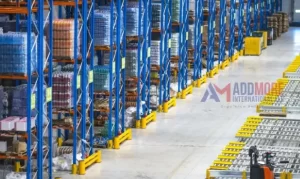Introduction
Are you seeking to maximize your warehouse’s storage capacity and organizational efficiency while remaining efficient and organized? An adequately designed warehouse racking system is necessary. In this comprehensive guide, we’ll explore all aspects of warehouse racking systems, from their benefits and types through choosing one to further optimizing operations such as shelving or mezzanine floors – and more!
Understanding Warehouse Racking Systems
A warehouse racking system is a framework of storage units that allows for the systematic organization and efficient storage of goods in a warehouse setting. These systems are designed to maximize available space, streamline inventory management, and optimize overall warehouse operations. By utilizing a warehouse racking system, businesses can ensure easier accessibility to products, improve workflow and increase productivity.
Benefits of Implementing Warehouse Racking Systems
Implementing a warehouse racking system offers numerous advantages for businesses of all sizes. Let’s explore some of the key benefits you can expect:
Optimized Space Utilization:
Warehouse racking systems make efficient use of available vertical and horizontal space. Businesses can significantly increase their storage capacity without expanding their physical footprint by stacking products vertically and utilising different storage configurations.
Improved Inventory Management:
With organized storage locations and proper labelling systems, a warehouse racking system allows for better inventory management. The systematic arrangement of products enables easy tracking, accurate stock management, and faster order fulfilment.
Enhanced Accessibility:
Easy accessibility to products is crucial for efficient warehouse operations. Warehouse racking systems provide clear visibility and easy access to goods, minimizing the time spent searching for specific items and improving overall picking and packing processes.
Enhanced Safety:
Safety is a paramount concern in any warehouse setting. Warehouse racking systems are designed to meet safety regulations and ensure the well-being of employees. Businesses can create a safe working environment by utilizing sturdy materials, incorporating safety features, and following proper installation and maintenance procedures.
Increased Efficiency and Productivity:
By implementing a warehouse racking system, businesses can reduce unnecessary manual handling and streamline their processes. This increased efficiency translates to higher productivity, as employees spend less time navigating through cluttered spaces and can focus on core tasks.
Cost Savings:
Optimizing storage space through warehouse racking systems can save businesses considerable expenses by making better use of their existing space and decreasing the need for extra facilities. By maximizing existing capacities and using them more efficiently, businesses can maximize existing capacity while reducing additional storage needs.
Now that we understand the advantages of warehouse racking systems let’s investigate the available types.
Types of Warehouse Racking Systems
Various warehouse racking systems are available, each catering to specific storage and operational needs. Understanding your options will enable you to select the most suited to your business. Here are some commonly utilized systems:
Selective Pallet Racking
Selective pallet racking is one of the most popular and widely used warehouse racking systems. It consists of horizontal rows of racks with multiple levels where palletized goods are stored. These racks can be easily accessed from both sides, allowing for quick and efficient retrieval of products. Selective pallet racking suits businesses with many SKUs and high product turnover.
Drive-In Racking
Drive-in racking systems are designed for high-density storage and are ideal for businesses with a large volume of the same SKU. This system allows forklifts to enter the racks and place pallets on the supporting beams. Unlike selective pallet racking, drive-in racking operates on a last-in, first-out (LIFO) principle, where the last pallet stored is the first to be retrieved. This system maximizes space utilization but may not be suitable for businesses with various products.
Push Back Racking
Push-back racking systems offer high-density storage while maintaining selectivity and accessibility. These systems utilize inclined carts that allow pallets to flow smoothly along the rails. When a new pallet is loaded, it pushes the previously loaded pallet further back. Pushback racking operates on a last-in, first-out (LIFO) principle and efficiently utilises space. It suits businesses with moderate to high product turnover and limited space.
Mezzanine Floors
Mezzanine floors are elevated platforms that create additional levels within a warehouse, effectively expanding the available storage space. These freestanding structures can be installed to maximize vertical space without significantly altering the existing building. Mezzanine floors are versatile, allowing businesses to create office spaces, additional storage areas, or retail spaces within their warehouse. When integrated with a warehouse racking system, mezzanine floors can significantly increase storage capacity while maintaining efficient operations.
Warehouse Shelving: A Complementary Solution
While warehouse racking systems excel at storing palletized goods and more oversized items, warehouse shelving provides an effective solution for smaller items and loose inventory. Let’s explore the benefits of incorporating warehouse shelving:
Benefits of Warehouse Shelving
Warehouse shelving systems offer a range of benefits that complement warehouse racking systems:
Organization and Accessibility:
Warehouse shelving provides a space-efficient solution for organizing and storing small items such as cartons, spare parts, and supplies. With clearly labelled shelves and easy access, employees can quickly locate and retrieve items, minimizing search times and optimizing efficiency.
Stock Rotation and FIFO:
Warehouse shelving is handy for inventory management techniques such as first-in, first-out (FIFO). By implementing shelving systems, businesses can easily organize products and ensure proper stock rotation to prevent spoilage or obsolescence.
Flexibility:
Warehouse shelving systems come in various configurations, from static to mobile and multi-tier configurations, allowing businesses to find an optimal shelving solution that best meets their inventory and operational needs.
Conclusion:
As warehouse optimization becomes an ever-evolving field, combining modern racking systems with efficient shelving solutions is an innovative game-changer. An integrated combination of selective pallet rack drives-in racking, drive-in racking, and push-back racking combined with flexible mezzanine floors and bolt-free shelving solutions allows businesses to increase storage capacity and operational efficiency. Addmore International has long been at the forefront of innovative storage solutions. Now, they continue their revolutionary journey as one of their pioneering partners. Addmore International is your trusted partner in providing quality and timely services with innovative ways of transforming spaces for maximum storage effectiveness while adding aesthetic value. Experience better warehouse storage technology through Addmore International; storage is our passion.










